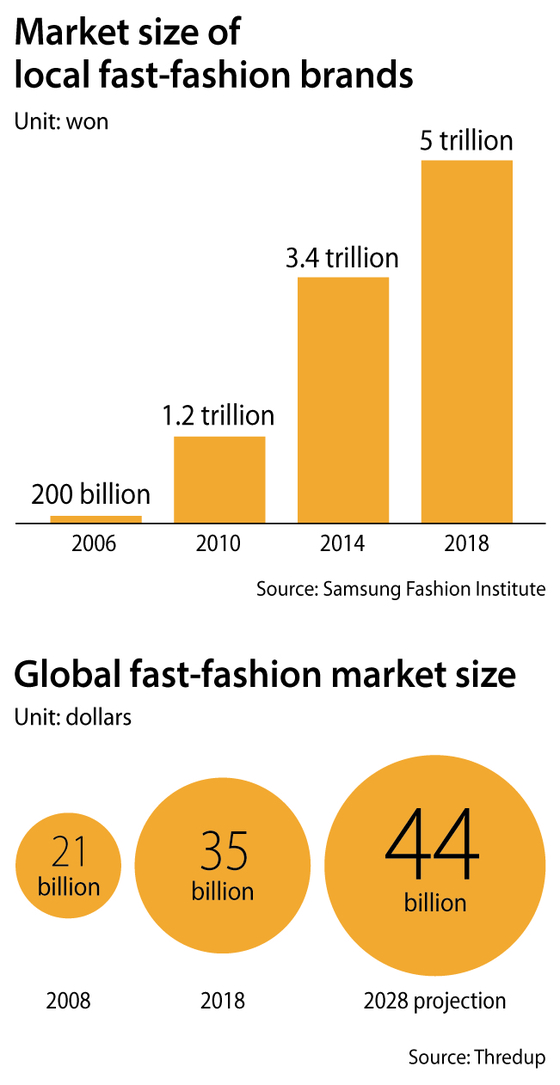Local fast fashion booms as Uniqlo tanks, pandemic hits
As consumers cut costs and shun Uniqlo, they have been looking more toward local fast-fashion brands.Business is so good that Eland is turning six of its women’s clothing businesses, including Roem, into independent entities and spinning them off.
Total sales of the brands last year was 300 billion won ($274 million). Despite the high sales, the company decided to sell them and use the funds to invest in its fast-fashion brand SPAO.
SPAO’s sales in 2015 were about 240 billion won. In 2019, the value rose to 320 billion won. By the end of this year, SPAO’s sales are projected to rise further to 350 billion won.
“Following a reshuffling of our portfolio, Eland is planning to enhance the global competitive edge of SPAO and develop it into a brand that records an annual 3 trillion won in sales within the next 10 years,” said a spokesperson for Eland.
Local fast-fashion brands, also known as SPA brands in Korea, include SPAO, 8seconds and Topten. Fast-fashion brands take charge of the entire process, from design to production and distribution. This allows the prices of these brands to be more competitive than conventional brands that hire outside manufacturers and distributors. This way, companies can apply fashion trends to their clothes in a timely manner.
Fast-fashion brands copy catwalk trends and bring them quickly to the market.
Besides SPAO, other fast-fashion brands owned by big businesses are on the rise. Samsung C&T’s 8Seconds and Shinsung Tongsang’s Topten have been growing at a fast rate. Topten’s sales rose by 36 percent on year to around 340 billion won in 2019, exceeding SPAO’s performance. The two brands are expected to further grow in sales during the rest of 2020.

The faltering performance of Uniqlo, which used to be the indisputable No. 1 in Korea’s fast-fashion market, has helped. As Uniqlo’s performance worsened since an informal boycott began after Japan introduced controls on exports of some key products to Korea.
Before the boycott, Uniqlo was close to achieving 2 trillion won in annual sales, but last year Uniqlo’s sales were 975 billion won, a 31 percent on-year drop. The company went into deficit after experiencing a 2-billion-won operating loss.
The demand for the local substitutes has been rising since then. Topten’s equivalents of Uniqlo’s thermal clothing line Heattech and Airism, a breathable clothing line for the summer, have been driving the increase in the company’s sales.
The coronavirus pandemic also contributed to the increased sales of fast-fashion brands. The overall fashion industry shrunk as people are discouraged from outdoor activities and spend less on outerwear, but the demand for fast-fashion clothing has been recovering. In 2006, Korea’s fast-fashion market was 200 billion won. The market kept growing for over 10 years: The value was 1.2 trillion in 2010, 3.4 trillion won in 2014 and 5 trillion won in 2018.
The cost efficiency of fast-fashion brands has caught the attention of the younger generations worldwide, becoming a growing trend in the global fashion industry. In 2018, the global market for fast fashion was $35 billion. Other than Uniqlo, Spanish brand Zara and Swedish retailer H&M emerged as some of the top fast-fashion brands.
The growth stagnated after California-based fashion retailer Forever 21 filed for bankruptcy in September 2019, closing stores in the United States and exiting most international locations.
As the coronavirus pandemic wears on, there has been a rising demand for everyday wear like fleeces and leggings, which are specialties of fast-fashion brands. Athleisure brands are gaining popularity as people engage in indoor sports and outdoor sports without much contact, like mountain climbing and camping. According to the Korea Research Institute for Fashion Industry, Korea’s athleisure clothing market is expected to grow from 1.5 trillion won in 2015 to 3 trillion won by the end of this year.
In the face of the changing market, local fast-fashion brands are starting to expand their target audience to include foreign customers. SPAO in February has introduced an activewear line with 40 kinds of clothing items, including leggings. Topten introduced clothing lines for yoga and Pilates, strengthening its athleisure segment. Companies are ramping up their e-commerce businesses, which have been increasingly important during the pandemic. The online sales for 8seconds this year increased by 26 percent on year.
“Consumption has been polarizing, as people strictly judge cost efficiency for brands outside of some luxury brands,” said Seo Yong-gu, a professor of business administration at Sookmyung Women's University. “A local fast-fashion brand’s popularity will continue to rise as they offer clothes with relatively affordable price ranges and sizes suited for Koreans.”
BY LEE CHANG-GYUN, LEE JEE-YOUNG [lee.jeeyoung1@joongang.co.kr]










with the Korea JoongAng Daily
To write comments, please log in to one of the accounts.
Standards Board Policy (0/250자)